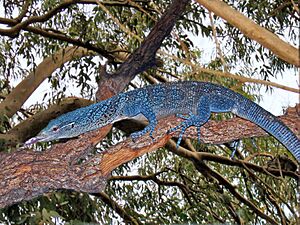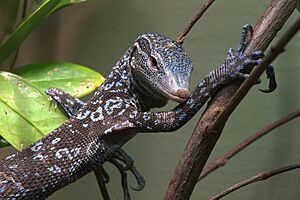Blue-spotted tree monitor facts for kids
Quick facts for kids Blue-spotted tree monitor |
|
|---|---|
 |
|
| Conservation status | |
| Scientific classification | |
| Genus: |
Varanus
|
| Species: |
macraei
|
| Synonyms | |
|
|
The blue-spotted tree monitor (also called the blue tree monitor) is a type of monitor lizard. Its scientific name is Varanus macraei. You can find this lizard on the island of Batanta in Indonesia. It was named after Duncan R. MacRae, who studied reptiles and started a reptile park in Bali.
Contents
Where Blue-Spotted Tree Monitors Live
The blue-spotted tree monitor lives only on Batanta island. This island is located near the tip of the Vogelkop peninsula in Indonesia. Like its relatives, this monitor lizard spends its life climbing trees. It has a special tail that can grip branches, which helps it move around in the trees.
Batanta island is quite small, only about 450 square kilometers. This means the blue-spotted tree monitor has one of the smallest living areas of any tree monitor.
What is Their Home Like?
Blue-spotted tree monitors live in warm, wet tropical forests. The temperature in these forests is usually between 28 and 38 degrees Celsius (83–100 degrees Fahrenheit). During the dry season, the air is about 65% humid. But in the wet season, the humidity can go up to 100%.
What Do Blue-Spotted Tree Monitors Look Like?
The blue-spotted tree monitor is mostly black. It has many bright blue scales scattered across its body. These blue scales often form eye-like spots or even bands across its back. The tip of its nose is light blue. Its lower jaw is white, and it has green scales on its neck that form a V-shape.
It has less than 9 blue bands across its back. Its legs are covered with many turquoise blue spots. There are about 85 to 103 rows of scales around the middle of its body. A clear blue line of scales runs from its eye to the top of its ear. Its throat is light with dark spots that look like a net.
Like other tree monitors, its tail can grab onto things. It has 22 to 23 blue rings that are mostly even. The tail is almost twice as long as its body (from snout to vent).
Male blue-spotted monitors grow larger than females. Males can reach about 1.1 meters (3.5 feet) in total length. Females are usually about 10 centimeters (4 inches) shorter than males. This makes the blue-spotted tree monitor the largest known species in its group of tree monitors.
How Do They Behave and What Do They Eat?
These lizards are active during the day and live in trees. If a predator comes near, they quickly climb up a tree. They hide by keeping the tree trunk between themselves and the danger.
Scientists haven't studied their diet much in the wild. However, it's believed they mainly eat insects like stick insects, grasshoppers, and crickets. They also eat moths, beetles, smaller lizards, and sometimes small eggs or berries.
History and Protection
About ten years ago, only five types of tree monitors were known. But in the early 2000s, scientists discovered and named new ones, including the blue-spotted tree monitor. These new species look very similar to each other, which made them hard to tell apart.
Many zoos and reptile keepers have successfully raised and bred blue-spotted monitors. This includes places like the Cincinnati Zoo and the Virginia Zoo.
Unfortunately, blue-spotted tree monitors are sometimes caught illegally from the wild. They are then sold in the international pet trade. This illegal collection is causing their numbers in the wild to drop. It is a threat to their survival. In Indonesia, the blue-spotted tree monitor is a protected species. This means it is against the law to collect them from the wild.




